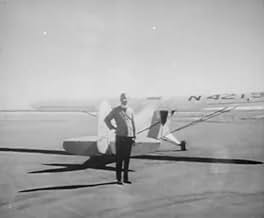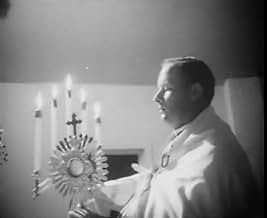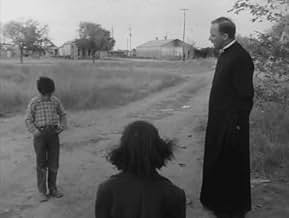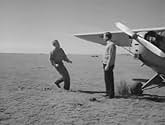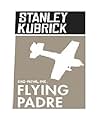अपनी भाषा में प्लॉट जोड़ेंTwo days in the life of priest Father Fred Stadtmuller whose New Mexico parish is so large he can only spread goodness and light among his flock with the aid of a monoplane. The priestly pil... सभी पढ़ेंTwo days in the life of priest Father Fred Stadtmuller whose New Mexico parish is so large he can only spread goodness and light among his flock with the aid of a monoplane. The priestly pilot is seen dashing from one province to the next at the helm of his trusty Piper Cub admin... सभी पढ़ेंTwo days in the life of priest Father Fred Stadtmuller whose New Mexico parish is so large he can only spread goodness and light among his flock with the aid of a monoplane. The priestly pilot is seen dashing from one province to the next at the helm of his trusty Piper Cub administering guidance (his plane, the Flying Padre) to unruly children, sermonizing at funeral... सभी पढ़ें
- निर्देशक
- लेखक
- स्टार
फ़ीचर्ड समीक्षाएं
It follows two days in the life of priest Father Fred Stadtmuller whose New Mexico parish is so large he can only spread goodness and light among his flock with the aid of a mono-plane. The priestly pilot is seen dashing from one province to the next at the helm of his trusty Piper Club administering guidance to unruly children, sermonizing at funerals and flying a sickly child and its mother to hospital.
In the light of Kubrick's later deeply ironic works, one is tempted to view these events in a slightly sinister, mischievous light. However its ironic sense can only be derived from its ludicrous, super-earnest newsreel format - commonplace at the time. Kubrick was to put such a format to good, unsettling use with the voice-over introduction to Dr Strangelove, Alex's voice-over in Clockwork Orange, Michael Horden's instructing tones in Barry Lyndon, and Private Joker's darkly humorous commentary in Full Metal Jacket. With this film, no such irony was intended (I think).
This is a strictly by-the book programmer; a second feature documentary made by a twenty-three year old future maestro for money, experience, and industry kudos. There are no real signs of Kubrick's later talent for pictorial composition (even though he was at this point a noted photo-journalist) or razor sharp narrative intellect. Although it is a perfectly competent piece, Flying Padre is virtually indistinguishable in form and content from any other programmer of the period.
Yet it is Kubrick and as such it's a valuable document in the early development of one of film's greatest artists. But for a real hint of what was to come, one should look at Kubrick's Day of the Fight made a year earlier. Invention, control of form, photographic dazzle, and energy. It's all there... except the irony. That was to arrive with Fear and Desire (1953).
It's really hard to find any Kubrick's later trademarks here, in fact it's nearly impossible even recognize it's directed by him if you don't know it already nor catch his name in the opening credits. I really wouldn't recommend this except for its curiosity values.
We follow a flying padre doing stuff most fathers (the religious type) do. The only special thing here is the fact that this man travels by plane since the area he is connected to is pretty big. Not that special I guess. Even the technique and ways of telling a story Kubrick used in later and even earlier work is not there.
Told very straight forward, it is eight minutes from a master doing a not very masterful thing. Interesting in a way, worth watching since it only takes eight minutes of your time.
Narrated by CBS announcer Bob Hite, "Flying Padre" tells the story of two days in the life of Father Fred Stadtmuller, a Catholic priest in rural New Mexico with a very particular way of reaching the people of his 400-square mile parish. Since his parish is too large and the roads of New Mexico aren't really good, Father Stadmuller uses a Piper Cub airplane to travel to whenever his people needs him, offering not only spiritual help, but sometimes also physical. Through the film, we follow this "Flying Padre" through his daily obligations, which not only include giving sermons at the church or helping people to solve their differences peacefully, as Father Stadmuller also uses his plane to help people in emergencies. In the movie for example, Father Stadmuller takes a sick child and his mother from their isolated ranch to the nearest hospital.
Based on Stadtmuller's experiences as priest of the New Mexico community of Mosquero, Stanley Kubrick wrote the screenplay for this brief recounting of several of Stadtmuller's adventures as Mosquero's "Flying Padre". Contrary to what the narration may tell, while the events portrayed in the movie did happen, what we see on screen is only a reenactment of them, not an actual depiction of Stadtmuller at work. Despite the fact that what it's on screen is obviously staged, Kubrick makes a great job at making us discover the true heroism behind the humble priest, and to a certain extent it's very informative about the situation of New Mexico's rural land of those years. The text of the narration (apparently also written by Kubrick) is very in tone with what was the standard in the early 50s, although often falls in the clichés of the era.
While his work with the screenplay doesn't show any sing of the talent that would make him a legend, the excellent camera-work he uses in the shooting of the film is a clear display of the abilities of the promising director. As he did in "Day of the Fight", Kubrick employs a mix of editing and cinematography to create a very dynamic movie in the style of Max Ophüls (who was a big influence in his early years). While of course Kubrick is forced to remain true to the newsreel's conventions, he manages to create pretty good looking scenes that at times seem to tell the tale of the "Flying Padre" in better fashion than Bob Hite's fast narrative. Sadly, the film's cinematography is probably the only think that would make one see this movie as a Kubrick film, as it is probably the only element that shows Kubrick's rising talent as a filmmaker.
What I mean is that not only the screenplay is troubled, where the movie truly suffers the most is in the quality of the reenactment of several events in the priest's life. The problem is that since neither the "actors" (people literally playing themselves) nor the director had any experience in this aspect, the result is a "documentary" that feels staged and fake when it should be the exact opposite. Another of the problems is definitely Nathaniel Shilkret's score for the film and the way Kubrick uses it in the movie. While Shilkret was one of the best composers for newsreels during the Golden age of the genre (and even composed for feature films in the 30s), his work in this movie sounds old, clichéd and archaic, a sad ending for his long career.
Even when "Flying Padre" is definitely a flawed film, it is still an interesting piece of history as it shows the development of Stanley Kubrick's career from young photographer to legendary filmmaker. While the writing and the directing of actors leaves a lot to be desired, the camera-work and the cinematography are 100% Kubrick and it shows. It is very easy to dismiss this movie as a mere curiosity, but one has to remember that in only 4 years Kubrick went from this movie to "Killer's Kiss" and his first two masterpieces, "The Killing" and "Paths of Glory". Of his three first documentaries this is probably the worst, and I don't doubt it could be seen as disappointing; but as people say, "you have to start with something". 5/10
This is only for curiosity value, being made by Kubrick it has none of his mark on it. Its just for getting a foot in the industry I guess, or money. Situations are clearly staged and not so very well done, the voice-over is one sided and the shooting is diverse, but serves no special purpose. Kubrick the perfectionist turned up later I guess.
क्या आपको पता है
- ट्रिवियाProduction #14208.
- क्रेज़ी क्रेडिटThe narrator identifies Father Stadmueller.
- कनेक्शनFeatured in The Art of Stanley Kubrick: From Short Films to Strangelove (2000)
टॉप पसंद
विवरण
- रिलीज़ की तारीख़
- कंट्री ऑफ़ ओरिजिन
- भाषा
- इस रूप में भी जाना जाता है
- Screenliners (1950-1951 season) #8: Flying Padre
- फ़िल्माने की जगहें
- उत्पादन कंपनी
- IMDbPro पर और कंपनी क्रेडिट देखें
- चलने की अवधि
- 9 मि
- रंग
- पक्ष अनुपात
- 1.37 : 1

